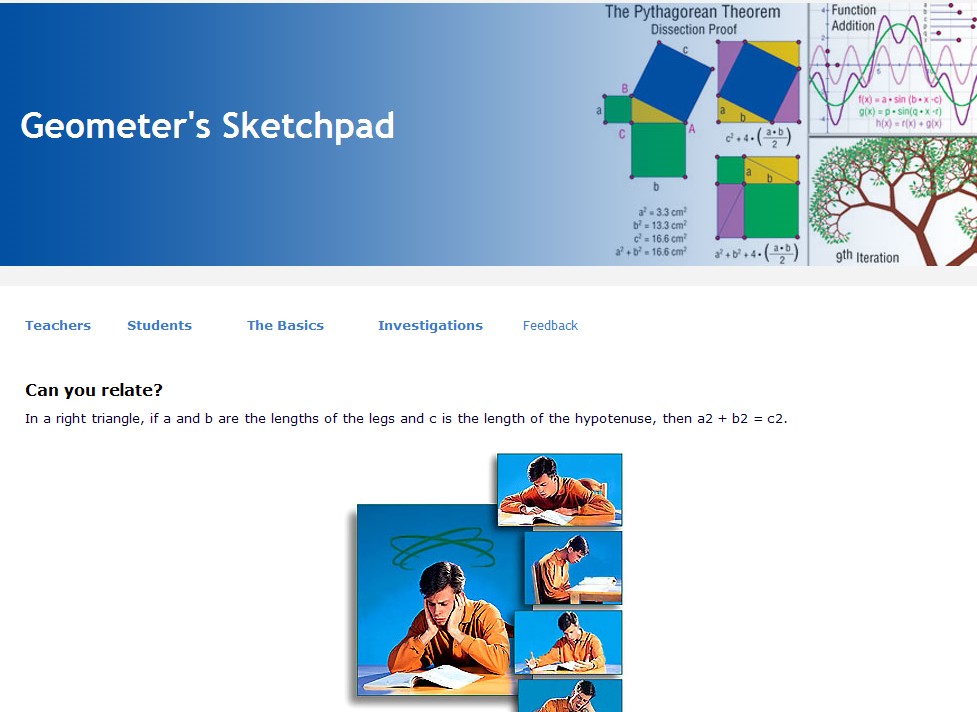Standard
Communication: Communicate clearly to achieve professional goals using visual and verbal modes to explain and persuade.
Artifact Context
Spring 2008 EDTEC 544
Geometer's Sketchpad Workshop
Individual Project
In December 2009, I accepted a one-semester, high school geometry, teaching assignment to replace a teacher who retired abruptly. The students I inherited expressed extreme frustration by their previous teacher's instructional delivery. Many had mentally checked out of the class. I discussed technological enhancements to instruction with the department head and learned that the mathematics department did not integrate technology into their curriculum. I decided to pursue the use technology in my classroom. Other teachers were interested but felt that I was making work for myself. I developed the Geometer's Sketchpad Resource Center and software workshop to explain the functionality to other teachers with the goal of persuading them to integrate the software in their curriculum.

Link to Standard
The geometry curriculum used and inductive approach. Rather than providing postulates and theorems, students derived them through pencil and paper investigations. Often, the students would focus on the perfection of the constructions and use of geometry tools rather than the conceptual knowledge to be gained. After discovering a data projector in our math storage room, I replaced the investigations created by hand with digital constructions using Geometer's Sketchpad software. Using software to develop constructions focused the students on the subject matter. The students' made steady learning gains and communicated positive feelings about the work. I decided to create a workshop for teachers that would train them in the use of a popular and powerful geometry program, Geometer's Sketchpad.
The Geometer's Sketchpad Resource Center web site contains several verbal and visual elements and is strategically designed to inform teachers of the benefits of the software. The carefully selected images that depict:
- A student frustrated with textbook-based work
- Smiling, engaged students working at computers 3
- Screen shots of the software's application to geometry, algebra, trigonometry, and calculus
- Student-created projects
The web site also contains verbally persuasive text that:
- Explains the benefits of using the software
- Contains several sample lessons
Student's blog post responses to the following prompts:
- How does this activity compare to the investigations you completed in the textbook?
- Which do you like better and why?
- How do you like the GSP program? Is it confusing, easy to use, fun to use, etc.
- What else would you like to share?
Of all of the persuasive elements, I believe that student comments are the most powerful. Every student’s post indicated his or her preference for computer-based investigations. Many stated that they felt they learned more deeply using this method.
Challenges and Opportunities
Although I am not an expert user of the software, there are numerous implementation guides available from the publisher and user community. Developing a workshop presented the opportunity for me to gain a deeper knowledge of the software's capabilities. As I investigated the software’s functionality, I learned of it's application to other courses taught by our math department. It was exciting to find out that almost every teacher in the department could replace student work done by hand with digital representations.
I conducted an audience analysis to learn more about my new colleagues' experiences with technology in the classroom. The survey revealed my first challenge: 80% of teachers believed that the software would support only students in geometry classes. Teachers' misconceptions would be a critical hurdle. I needed to develop materials that held value for everyone. I used this information to inform the development of visuals and text on the workshop web site, designed for self-directed learning . The visual and verbal information is designed to communicate the benefit of the software for students of all skill levels in various math courses. I also developed the framework for a face-to-face workshop that teaches the use of basic functions of the software. I will continue to build these resources and share them with other teachers in my district during our technology meetings.
The design document for the workshop exemplifies effective communication as well. I created flow charts to display the workshop content maps. I applied guidelines for creating flowcharts explaining a process that I found online to convey complex information in a consistent, understandable format. I created a job aid for myself during this process to assist me with flow chart creation in the future.
Professional and Personal Growth
This project offered practice with an issue many K-12 technology coordinators face, convincing teachers who do not enhance instruction with technology of the benefits for their students. The teachers at this site wrote pacing guides for their courses and planned to be on a specific page on a specific day. They taught the entire math book, beginning to end. There was a cultural resistance to change. The lesson learned in this project is to show the benefits of change, and not to go in with guns blazing. I believe that my approach was as beneficial in the process as resources I developed. On my last day at the school a veteran teacher showed up to secure the data projector before anyone else seized it. I also received communication from another math teacher requesting the URL to the resource web site I created.
References
Dick, W. & Reiser, R.A., (1996). Instructional Planning, A Guide for Teachers (2nd ed.). Needham Heights: Allyn and Bacon.
National Institute of Open Schooling, (n.d). Certificate in Computer Applications, Chapter 25. Retrieved February 2008, from http://www.nos.org/htm/basic2.htm.